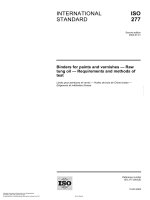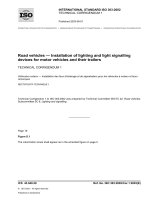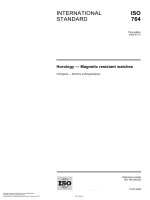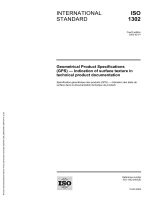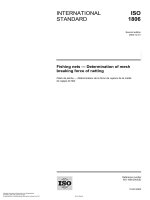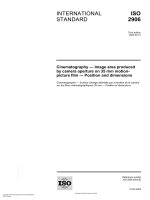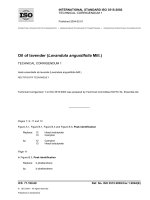Tiêu chuẩn iso 15473 2002
Bạn đang xem bản rút gọn của tài liệu. Xem và tải ngay bản đầy đủ của tài liệu tại đây (194.08 KB, 20 trang )
INTERNATIONAL
STANDARD
ISO
15473
First edition
2002-03-15
Soil quality — Guidance on laboratory
testing for biodegradation of organic
chemicals in soil under anaerobic
conditions
Qualité du sol — Lignes directrices relatives aux essais en laboratoire pour
la biodégradation de produits chimiques organiques dans le sol sous
conditions anắrobies
Reference number
ISO 15473:2002(E)
© ISO 2002
--`,,```,,,,````-`-`,,`,,`,`,,`---
Copyright International Organization for Standardization
Provided by IHS under license with ISO
No reproduction or networking permitted without license from IHS
Not for Resale
ISO 15473:2002(E)
PDF disclaimer
This PDF file may contain embedded typefaces. In accordance with Adobe's licensing policy, this file may be printed or viewed but shall not
be edited unless the typefaces which are embedded are licensed to and installed on the computer performing the editing. In downloading this
file, parties accept therein the responsibility of not infringing Adobe's licensing policy. The ISO Central Secretariat accepts no liability in this
area.
Adobe is a trademark of Adobe Systems Incorporated.
Details of the software products used to create this PDF file can be found in the General Info relative to the file; the PDF-creation parameters
were optimized for printing. Every care has been taken to ensure that the file is suitable for use by ISO member bodies. In the unlikely event
that a problem relating to it is found, please inform the Central Secretariat at the address given below.
© ISO 2002
All rights reserved. Unless otherwise specified, no part of this publication may be reproduced or utilized in any form or by any means, electronic
or mechanical, including photocopying and microfilm, without permission in writing from either ISO at the address below or ISO's member body
in the country of the requester.
--`,,```,,,,````-`-`,,`,,`,`,,`---
ISO copyright office
Case postale 56 • CH-1211 Geneva 20
Tel. + 41 22 749 01 11
Fax + 41 22 749 09 47
Web www.iso.ch
Printed in Switzerland
ii
Copyright International Organization for Standardization
Provided by IHS under license with ISO
No reproduction or networking permitted without license from IHS
© ISO 2002 – All rights reserved
Not for Resale
ISO 15473:2002(E)
Contents
Foreword.....................................................................................................................................................................iv
Introduction .................................................................................................................................................................v
Scope .............................................................................................................................................................. 1
2
Normative references .................................................................................................................................... 1
3
Terms and definitions ................................................................................................................................... 1
4
Principle.......................................................................................................................................................... 3
5
Materials ......................................................................................................................................................... 3
6
Collection, handling and storage of soil ..................................................................................................... 6
7
Procedure ....................................................................................................................................................... 6
8
Expression of results .................................................................................................................................... 9
9
Test report .................................................................................................................................................... 10
--`,,```,,,,````-`-`,,`,,`,`,,`---
1
Bibliography .............................................................................................................................................................. 11
iii
© ISO 2002 – All rights reserved
Copyright International Organization for Standardization
Provided by IHS under license with ISO
No reproduction or networking permitted without license from IHS
Not for Resale
ISO 15473:2002(E)
Foreword
International Standards are drafted in accordance with the rules given in the ISO/IEC Directives, Part 3.
The main task of technical committees is to prepare International Standards. Draft International Standards adopted
by the technical committees are circulated to the member bodies for voting. Publication as an International
Standard requires approval by at least 75 % of the member bodies casting a vote.
Attention is drawn to the possibility that some of the elements of this International Standard may be the subject of
patent rights. ISO shall not be held responsible for identifying any or all such patent rights.
ISO 15473 was prepared by Technical Committee ISO/TC 190, Soil quality, Subcommittee SC 4, Biological
methods.
iv
Copyright International Organization for Standardization
Provided by IHS under license with ISO
No reproduction or networking permitted without license from IHS
© ISO 2002 – All rights reserved
Not for Resale
--`,,```,,,,````-`-`,,`,,`,`,,`---
ISO (the International Organization for Standardization) is a worldwide federation of national standards bodies (ISO
member bodies). The work of preparing International Standards is normally carried out through ISO technical
committees. Each member body interested in a subject for which a technical committee has been established has
the right to be represented on that committee. International organizations, governmental and non-governmental, in
liaison with ISO, also take part in the work. ISO collaborates closely with the International Electrotechnical
Commission (IEC) on all matters of electrotechnical standardization.
ISO 15473:2002(E)
Introduction
Organic chemicals can be introduced into the soil both intentionally and accidentally, after which they can degrade
as a result of biological action. For chemicals which do degrade, the rate of degradation can vary considerably,
depending not only on the molecular structure of the chemical, but also on soil conditions such as temperature,
water and oxygen availability which influence microbial activity. The activity of microorganisms often plays a major
role in degradative processes.
ISO 11266 [3] gives general guidelines for the selection and method of tests to determine the biodegradation of
organic chemicals in soils under aerobic conditions.
It is necessary to have laboratory tests available to estimate the rate and extent of biodegradation under anaerobic
conditions, and to assess the capability of soil to degrade organic chemicals under these conditions.
--`,,```,,,,````-`-`,,`,,`,`,,`---
This International Standard gives guidance for the method of tests to determine the biodegradation of organic
chemicals in soils under anaerobic conditions.
v
© ISO 2002 – All rights reserved
Copyright International Organization for Standardization
Provided by IHS under license with ISO
No reproduction or networking permitted without license from IHS
Not for Resale
--`,,```,,,,````-`-`,,`,,`,`,,`---
Copyright International Organization for Standardization
Provided by IHS under license with ISO
No reproduction or networking permitted without license from IHS
Not for Resale
INTERNATIONAL STANDARD
ISO 15473:2002(E)
Soil quality — Guidance on laboratory testing for biodegradation
of organic chemicals in soil under anaerobic conditions
1
Scope
This International Standard gives guidance on the selection and method of appropriate tests for the determination
of biodegradation of organic chemicals in soil samples under anaerobic conditions.
--`,,```,,,,````-`-`,,`,,`,`,,`---
NOTE
If the method is intended for tests in the framework of the registration of chemicals, an OECD Guideline on soil
degradation [20] gives useful guidance on additional test requirements.
2
Normative references
The following normative documents contain provisions which, through reference in this text, constitute provisions of
this International Standard. For dated references, subsequent amendments to, or revisions of, any of these
publications do not apply. However, parties to agreements based on this International Standard are encouraged to
investigate the possibility of applying the most recent editions of the normative documents indicated below. For
undated references, the latest edition of the normative document referred to applies. Members of ISO and IEC
maintain registers of currently valid International Standards.
ISO 10381-6:1993, Soil quality — Sampling — Part 6: Guidance on the collection, handling and storage of soil for
the assessment of aerobic microbial processes in the laboratory
ISO 10390:1994, Soil quality — Determination of pH
ISO 10694:1995, Soil quality — Determination of organic and total carbon after dry combustion (elementary
analysis)
ISO 11260:1994, Soil quality — Determination of effective cation exchange capacity and base saturation level
using barium chloride solution
ISO 11261:1995, Soil quality — Determination of total nitrogen — Modified Kjeldahl method
ISO 11271, Soil quality — Determination of redox potential — Field method
ISO 11274:1998, Soil quality — Determination of the water retention characteristic — Laboratory methods
ISO 11277:1998, Soil quality — Determination of particle size distribution in mineral soil material — Method by
sieving and sedimentation
ISO 14239:1997, Soil quality — Laboratory incubation systems for measuring the mineralization of organic
chemicals in soil under aerobic conditions
3
Terms and definitions
For the purposes of this International Standard, the following terms and definitions apply.
1
© ISO 2002 – All rights reserved
Copyright International Organization for Standardization
Provided by IHS under license with ISO
No reproduction or networking permitted without license from IHS
Not for Resale
ISO 15473:2002(E)
3.1
biodegradation
molecular degradation of an organic substance resulting from the actions of living organisms
[ISO 11266]
3.2
primary biodegradation
the degradation of a substance to an extent sufficient to remove some characteristic property of the parent
molecule. In practice this will be determined by analysis as a loss of parent compound or some specific function of
the parent compound
[ISO 11266]
3.3
ultimate biodegradation
breakdown of an organic compound to carbon dioxide, methane, water, mineral salts of any other elements
present, and products associated with the normal anaerobic processes of microorganisms
3.4
anaerobic transformation
reaction occurring under exclusion of oxygen (reducing conditions)
NOTE
Such a reaction generally occurs when the redox potential (Eh) is less than 200 mV [17].
3.5
persistence
residence time of a chemical species in a specifically defined compartment of the environment
[ISO 11266]
3.6
DT-50
disappearance time 50
time taken for the concentration of a given compound to be reduced by 50 % of its original value
[ISO 11266]
3.7
DT-90
disappearance time 90
time taken for the concentration of a given compound to be reduced by 90 % of its original value
[ISO 11266]
3.8
bound residue
non-extractable residue
chemical species in soils originating from, for example, organic molecules that are not extracted by methods which
do not significantly change the chemical nature of the residue
NOTE
These non-extractable residues are considered to exclude fragments recycled through metabolic pathways leading
to natural products [12].
3.9
soil
upper layer of the earth's crust composed of mineral parts, organic substances, water, air and living matter
[ISO 11074-1]
--`,,```,,,,````-`-`,,`,,`
2
Copyright International Organization for Standardization
Provided by IHS under license with ISO
No reproduction or networking permitted without license from IHS
© ISO 2002 – All rights reserved
Not for Resale
ISO 15473:2002(E)
3.10
test substance
chemical substance under investigation added to the test system
3.11
saturated soil
that part of the soil which is completely saturated by water
4
Principle
Two appropriate test methods are described:
a)
incubation of a test compound in the soil under methanogenic conditions and monitoring its biodegradation;
b)
incubation of a test compound in the soil under water-logged conditions and monitoring its biodegradation.
The latter method simulates conditions under natural anaerobic circumstances, whereas the former method makes
use of chemicals to induce a low redox potential in soil, and is the method of choice to measure the potential for
degradation in soil under methanogenic conditions. In the water-logged soil method, the establishment of a low
redox potential takes more time than under the methanogenic test conditions.
If the water-logged (“flooded”) conditions are chosen, the soil will establish conditions depending on the nature of
the soil. Such conditions can be nitrate-reducing (450 mV to 200 mV, pH 7), Fe-reducing (+ 150 mV to – 100 mV,
pH 7), or sulfate-reducing (– 50 mV to – 200 mV, pH 7). If “methanogenic” conditions are chosen, the redox
potential will be less than – 200 mV.
--`,,```,,,,````-`-`,,`,,`,`,,`---
The water-logging method is more appropriate for aerobic soils that may be transiently anaerobic. The
methanogenic conditions are more appropriate for organic marsh (permanently flooded) surface soils, soils of
landfills and sludge-amended soils.
NOTE
Organic soils containing easily degradable organic matter may eventually achieve methanogenic conditions under
water-logged test conditions.
After addition of the test compound to a selected soil (5.1), biodegradation is measured under anaerobic conditions
by following the production of carbon dioxide, methane and other volatiles. If such volatile compounds have to be
determined, the use of 14C (radioactive) substances is highly recommended. The disappearance of the test
compound can also be followed by substance-specific analysis.
It is also possible to use radio-labelled compounds to determine the rate of disappearance of the test compound
and the formation of metabolites and bound non-extractable residues. The metabolites can be identified using
appropriate analytical methods.
5
Materials
5.1
5.1.1
Soil
Selection and sampling
If practical, soils selected for testing should come directly from the site where chemical contact is anticipated.
However, if it is not possible to obtain samples owing to contamination which has already been introduced, the soil
selected should have properties as close as possible to the contaminated soil.
The field history of the soil used should be considered, and recent amendments (e.g. pesticide applications) and
tillage practices noted. Precise data should be provided on the sampling site, its location, its status of aeration (e.g.
colour, water content, smell), the presence of plants or previous crops, the date of removal of the sample from the
field, and the sampling depth.
3
© ISO 2002 – All rights reserved
Copyright International Organization for Standardization
Provided by IHS under license with ISO
No reproduction or networking permitted without license from IHS
Not for Resale
ISO 15473:2002(E)
5.1.2
Soil characteristics
A knowledge of soil characteristics is essential for full interpretation of the results of the study. It is therefore
recommended that at least the following tests be performed on the selected soil:
a)
b)
c)
physical properties:
1)
particle size analysis in accordance with ISO 11277;
2)
field water content by an appropriate method;
3)
total water-holding capacity and/or water-retention characteristics in accordance with ISO 11274;
chemical properties:
1)
pH of the soil in accordance with ISO 10390, or the pH in KCl or CaCl2 solution;
2)
organic matter content in accordance with ISO 10694;
3)
cation exchange capacity (CEC) in accordance with ISO 11260;
4)
nitrogen content in accordance with ISO 11261;
5)
redox potential in accordance with ISO 11271;
biological properties:
It may be useful to determine the microbial biomass of soil. This should be done by an appropriate method,
e.g. the substrate-induced respiration method [4]. However, if anaerobic biodegradation prevails in the
collected soil, the fumigation method [5] should be used.
5.2
Test substance
Ideally, substances to be tested should be pure compounds (chemical purity > 95 % mass fraction). The influence
of any carriers or formulation ingredients should also be considered.
The following data on compounds are important for the interpretation of results:
name (IUPAC);
structure;
relative molecular mass;
data on purity and the chemical nature of major impurities;
stability in water and in organic solvents;
solubility in water;
vapour pressure;
octanol/water partition coefficient;
sorption constant;
acid dissociation constant;
4
Copyright International Organization for Standardization
Provided by IHS under license with ISO
No reproduction or networking permitted without license from IHS
--`,,```,,,,````-`-`,,`,,`,`,,`---
Not for Resale
© ISO 2002 – All rights reserved
ISO 15473:2002(E)
for radio-labelled chemicals:
the nature and position of the label;
specific activity;
radiochemical purity.
NOTE
The results of studies using radio-labelled materials depend on the position of the radio-label. Therefore the
labelling positions within the molecular structure need careful consideration.
5.3
Glassware and apparatus
General laboratory equipment and glassware, in particular the following.
5.3.1
Round-bottomed flask (of about 250 ml and 500 ml).
5.3.2
Ice bath.
5.3.3
Column containing reduced copper.
5.3.4
Gassing line with syringes and gassing needles.
5.3.5
Glass tubes or flasks with butyl rubber stoppers.
5.3.6
Pipettes with PVC tubes of internal diameter 0,5 mm to 1 mm.
5.3.7
Gas-tight syringes (10 ml, 20 ml, 50 ml and 100 ml).
5.3.8
Apparatus and electrodes to measure redox potentials.
In addition, for studies with 14C-labelled test materials:
5.3.9
Scintillation cocktails.
5.3.10 Liquid scintillation counter.
5.3.11 Scintillation vials.
5.4
Reagents
All chemicals used should be of analytical grade.
5.4.1
Oxygen-free nitrogen, helium (pure) or argon.
5.4.2
Titanium(III) chloride.
5.4.3
Sodium citrate.
5.4.4
Potassium dihydrogenphosphate (KH2PO4).
5.4.5
Disodium hydrogenphosphate dihydrate (Na2HPO4 ⋅ 2H2O).
5.4.6
Sodium carbonate.
--`,,```,,,,````-`-`,,`,,`,`,,`---
5
© ISO 2002 – All rights reserved
Copyright International Organization for Standardization
Provided by IHS under license with ISO
No reproduction or networking permitted without license from IHS
Not for Resale
ISO 15473:2002(E)
5.4.7
Titanium(III) citrate.
Prepare the titanium citrate as follows. Neutralize 5 ml of titanium(III) chloride (15 %) (5.4.2) in 50 ml of 0,2 mol/l
sodium citrate (5.4.3) solution with saturated sodium carbonate (5.4.6) solution, filter if necessary, and store under
oxygen-free gas.
6
Collection, handling and storage of soil
7
--`,,```,,,,````-`-`,,`,,`,`,,`---
If soils in which aerobic processes prevail are collected, it is important that ISO 10381-6 be followed to ensure that
viability of soil microorganisms is maximized during sampling. If soils are collected in which anaerobic
biodegradation prevails, the sampling, handling and storage should minimize exposure of the soil samples to
oxygen.
Procedure
7.1
Addition of test substance
The concentration to be used in the test depends on the experimental objectives (e.g. concentration to be expected
in the field situation), and the test substance shall be applied either:
to the soil; or
to the aqueous phase covering the soil.
Anaerobic conditions shall be established in the test system before the test substance is applied to the water
phase.
The test substance may be added in a number of ways:
a)
as an aqueous solution (depending on the solubility in water);
b)
dissolved in organic, water-miscible solvents (depending on the solubility in the solvent). The amount of
solvent should be restricted to the minimum (< 1 %) necessary for the application of the compound. The
possible toxicity and biodegradability of the solvent should be taken into account;
c)
as a solid, e.g. coated on quartz sand (prior to mixing with the soil).
Care should be taken to avoid adding the test substance at toxic levels. Compounds which are toxic, or have
inhibitory effects on soil microorganisms at the applied concentration, interfere with the determination of
biodegradability.
7.2
7.2.1
Incubation under methanogenic conditions
Preparation of oxygen-free incubation medium
Place approximately 100 ml of water into a 250 ml or 500 ml round-bottomed flask (5.3.1), put the gassing needle
(5.3.4) into the water and flush it with a small stream of O2-free nitrogen or helium (5.4.1) which has passed a
column of heated copper (350 °C) (5.3.3). Boil the water vigorously under continuous gassing with the oxygen-free
gas for about 1 min. The water can then be kept anaerobic by replacing the vapour with oxygen-free nitrogen or
helium as the container cools in ice. After cooling, titanium(III) citrate (5.4.7) c = 0,8 mmol/l, KH2PO4 (5.4.4)
ρ = 0,27 g/l and Na2HPO4 ⋅ 2H2O (5.4.5) ρ = 0,56 g/l, are added and dissolved (hereafter referred to as “oxygenfree buffer”) [7].
6
Copyright International Organization for Standardization
Provided by IHS under license with ISO
No reproduction or networking permitted without license from IHS
© ISO 2002 – All rights reserved
Not for Resale
ISO 15473:2002(E)
7.2.2
Incubation system
The incubation system used should ensure that anaerobic conditions are maintained.
A rather small number of systems is available [7, 8, 9, 13, 14, 16, 18].
The system described in this International Standard consists of a glass flask (250 ml) (5.3.5) and a gassing system
with syringes and gassing needles (5.3.4). See for example the system in Figure 1. When tubing is used this
should be impermeable for gases (e.g. thick butyl rubber). The flask can be closed with a rubber stopper. However,
any other appropriate system can be used as well, provided that it follows the guidance of this International
Standard.
Key
1
2
Oxygen-free nitrogen
Glass tube or needle
3
4
Flask
Soil
5
6
Buffer
Stopper
Figure 1 — Example of an incubation system for anaerobic degradation studies in soil
If volatile substances such as 14CO2 have to be measured, flow-through or biometer incubation systems as
described in ISO 14239 should be used. In the flow-through system an inert gas should be used. The system in
Figure 1 is suitable as a flow-through system.
--`,,```,,,,````-`-`,,`,,`,`,,`---
7
© ISO 2002 – All rights reserved
Copyright International Organization for Standardization
Provided by IHS under license with ISO
No reproduction or networking permitted without license from IHS
Not for Resale
ISO 15473:2002(E)
7.2.3
Incubation
7.2.3.1
Preparation
Divide the soil into aliquots of at least 40 g (dry mass equivalent) and place them in incubation flasks (5.3.5).
Transfer enough of the prepared oxygen-free buffer (but at least approx. 1 cm of liquid should be above the soil
surface) into each flask containing soil, which shall be flushed continuously during preparation with an oxygen-free
stream of inert gas via a gassing needle. The buffer should be transferred via pipettes fitted with a long, thin PVC
tube (5.3.6; see also [7]). Immediately after removing the needle, close the flask with a butyl rubber stopper. Pierce
the stopper by a needle attached to an airtight syringe to prevent excess pressure and to allow the withdrawal of
gas samples for analyses, or connect to tubing as shown in Figure 1.
Generally at least two replicates per sampling point should be incubated. However, increasing the number of
replicates increases the precision of the test.
Controls should be run simultaneously and should contain soil plus the amount of buffer which was used for the
application of the test material in the treated samples.
Soil without any additives may be used as an additional control.
7.2.3.2
7.2.3.2.1
Incubation conditions
Maintaining anaerobicity
Anaerobic biodegradation in soils is considered to prevail if the redox potential is less than about 200 mV. For proof
of anaerobicity, see 7.2.3.3.
7.2.3.2.2
Temperature
The incubation temperature should be selected according to the specific goals of the study. In general, maximum
microbial activity in soil is found between 25 °C and 35 °C. For soils from temperate zones, a temperature between
10 °C and 25 °C is adequate and more representative of natural conditions.
7.2.3.2.3
--`,,```,,,,````-`-`,,`,,`,`,,`---
The minimum and maximum temperatures should be measured and recorded at regular intervals throughout the
incubation and should not vary by more than ± 2 °C.
Illumination
The test should be conducted in the dark.
7.2.3.3
Proof of anaerobicity
Check the anaerobicity occasionally during the study by measuring the redox potential in accordance with
ISO 11271.
At the end of the test, measure dissolved Fe, dissolved Mn and NH4+/NO2−/NO3− concentrations.
7.2.3.4
Test duration
There is no minimum duration recommended for a test but, as microbial activity in soil decreases during longer
incubation periods, it is recommended that tests not be continued for longer than 100 days.
7.2.3.5
Sampling
Sampling should be carried out at regular intervals during the incubation period, the frequency depending on the
duration of the test and the rate of biodegradation of the test substance. At least five sampling points are required
to establish a degradation curve. Where materials degrade rapidly during the early stages of incubation, the
8
Copyright International Organization for Standardization
Provided by IHS under license with ISO
No reproduction or networking permitted without license from IHS
© ISO 2002 – All rights reserved
Not for Resale
ISO 15473:2002(E)
following sampling frequency is recommended: 0, 2, 4, 8, 16, 40 and 100 days after application of the test
substance. For destructive sampling methods, e.g. direct analysis of the soil, it is recommended that the entire
contents of an individual incubation flask be tested.
7.3
Incubation under water-logged conditions
It is common practice to cover soil with water (approx. 1 cm above the soil) to reach anaerobic conditions in the soil
[19, 20].
Proceed as under 7.2.1 to 7.2.3.5, but instead of using buffer (7.2.3), use water.
This water-logged system has a much higher redox potential value than the system treated with oxygen-free buffer
(7.2). Normally the water-logged system has a positive redox potential value, while the oxygen-free-buffered
system has a negative value.
7.4
Degradation monitoring
7.4.1
General
The type of analyses chosen to monitor the degradation process will depend on the aims of the study and whether
primary and/or ultimate biodegradation data are required.
The analyses are dependent on the chemical itself and whether a radio-labelled compound has been used.
In general the following analyses should be considered:
For primary degradation (unlabelled substances):
b)
loss of parent compound.
For metabolism, including ultimate degradation (labelled substances):
determination of volatile compounds, both parent compound and metabolites;
determination of water/or solvent extractables;
determination of “bound”, non-extractable residues.
--`,,```,,,,````-`-`,,`,,`,`,,`---
a)
For determination of extractable materials, solvents which do not alter the parent compound or its metabolites
should be used. Care should be taken to follow extraction procedures which will remove as much of the extractable
material as possible. The analysis of metabolites and parent compound may be performed using thin layer
chromatography (TLC), high performance liquid chromatography (HPLC) and gas chromatography (GC).
Measurement of 14CO2 production
7.4.2
14CO
7.4.3
14CH
2
production can be determined using methods specified in ISO 14239.
Measurement of 14CH4 production
can be determined via oxidation to 14CO2 using copper oxide. Before carrying out this procedure,
means should be provided to trap by soda lime the natural CO2 produced in this experiment.
8
4 production
Expression of results
All data should be presented in tabular and graphic form (degradation curve).
9
© ISO 2002 – All rights reserved
Copyright International Organization for Standardization
Provided by IHS under license with ISO
No reproduction or networking permitted without license from IHS
Not for Resale
ISO 15473:2002(E)
DT-50 and DT-90 values should be calculated using, for example, the models described in [15] or other appropriate
models.
Additional useful information includes the determination of volatile compounds, formation and persistence of
metabolites and non-extractable residues.
NOTE
If no biodegradation is observed, the likely reasons are that:
a)
the test substance is toxic;
b)
the test substance does not biodegrade;
c)
the microbial activity of the soil is zero;
d)
the test substance is not bioavailable (because of adsorption or volatilization).
9
Test report
The test report should include the following information:
a)
data on the test substance (see 5.2);
b)
data on the soils used (see 5.1);
c)
data on the test procedure, test method used, concentrations used, methods of application, data on
performance of the test, proof of anaerobicity, sampling data etc. (see clause 5);
d)
data on the analytical methods used, e.g. detection limits, quality control procedures, reference substances
analysed;
e)
raw data on the results of the analysis;
f)
if 14C-labelled test substance is used, a mass balance (optional);
g)
evaluation and conclusions of the evaluation.
10
Copyright International Organization for Standardization
Provided by IHS under license with ISO
No reproduction or networking permitted without license from IHS
--`,,```,,,,````-`-`,,`,,`,`,,`---
© ISO 2002 – All rights reserved
Not for Resale
ISO 15473:2002(E)
Bibliography
ISO 9408:1999, Water quality — Evaluation of ultimate aerobic biodegradability of organic compounds in
aqueous medium by determination of oxygen demand in a closed respirometer
[2]
ISO 11074-1:1996, Soil quality — Vocabulary — Part 1: Terms and definitions relating to the protection and
pollution of the soil
[3]
ISO 11266:1994, Soil quality — Guidance on laboratory testing for biodegradation of organic chemicals in
soil under aerobic conditions
[4]
ISO 14240-1:1997, Soil quality — Determination of soil microbial biomass — Part 1: Substrate-induced
respiration method
[5]
ISO 14240-2:1997, Soil quality — Determination of soil microbial biomass — Part 2: Fumigation-extraction
method
[6]
AHLRICHS, J.L. in: Organic Chemicals in the Soil Environment, Goring, C.A.I., and Hamaker J.W., eds.,
Dekker, New York, 1972, p. 40
[7]
ALEF, K., NANNIPIERI, P. Methods in applied soil microbiology and biochemistry, Academic Press, London,
1995, pp. 271-310
[8]
ATTAWAY, H.H., PAYNTER, M.J.B. and CAMPER, N.D. Degradation of selected phenylurea herbicides by
anaerobic pond sediment, J. Environ. Sci. Health, B17 (6), 1982, pp. 683-699
[9]
BELAND, F.A., FARWELL, S.O. and GEER, R.D. Anaerobic degradation of 1,1,1,2-Tetrachloro-2,2-bis
(p-chlorophenyl)ethane (DTE), J. Agr. Food Chem., 22, 1974, pp. 1148-1149
[10]
GOWDA, T.K.S and SETHUNATHAN, N. Persistence of Endrin in Indian soils under flooded conditions, J. Agric.
Food Chem., 24, 1976, pp. 750-753
[11]
HEALY, J.B. and YOUNG, L.Y. Anaerobic biodegradation of eleven aromatic compounds to methane, Appl.
and Environ. Microbiol., 38, 1979, pp. 84-89
[12]
--`,,```,,,,````-`-`,,`,,`,`,,`---
[1]
KEARNEY, Ph.C. IUPAC Pesticide Commission Report, Technical Communication, J. Assoc. Off. Anal.
Chem., 65, 1982, pp. 1030-1032
[13]
MADSEN, T., BECK-RASSMUSSEN, H., NILSSON, L. Methods for screening anaerobic biodegradability and
toxicity of organic chemicals, Miljoprojekt No. 336, 1996
[14]
SHELTON, D.R. and TIEDJE, J.M. General method for determining anaerobic biodegradation potential, Appl.
Environ. Microbiol., 47 (4), 1984, pp. 850-857
[15]
TIMME, G., FREHSE, H. and LASKA, V. Interpretation and graphischen Darstellung des Abbauverhaltens von
Pflanzenschutzmittel-Rückständen, II. Pflanzenschutz-Nachrichten Bayer, 39, 1986, pp. 188-204
[16]
W ARD, T.E. Aerobic and anaerobic biodegradation of nitrilotriacetate in subsurface soils, Ecotoxicol.
Environmental Safety, 11, 1986, pp.112-125
[17]
W OLFE, N.L., MINGELGRIN U., MILLER, G. Abiotic transformations in water, sediments and soils. In: Cheng,
H.H. (ed.), Pesticides in the soil environment: processes, impacts and modelling, SSSA Book Series 2,
1990, pp. 103-168
11
© ISO 2002 – All rights reserved
Copyright International Organization for Standardization
Provided by IHS under license with ISO
No reproduction or networking permitted without license from IHS
Not for Resale
ISO 15473:2002(E)
ZORO, J.A., HUNTER, J.M., EGLINTON, G. and W ARE, G.C. Degradation of p,p'-DDT in reducing
environments, Nature, 247, 1974, pp. 235-237
[19]
U.S. Environmental Protection Agency, Washington DC, Pesticide Assessment Guidelines, Subdivision N
Chemistry: Environmental Fate, Oct. 18, 1982, §162-2 Anaerobic soil metabolism studies
[20]
OECD Guideline 307 for Testing of Chemicals, Final Document (2000), Aerobic and Anaerobic
Transformation in Soil
--`,,```,,,,````-`-`,,`,,`,`,,`---
[18]
12
Copyright International Organization for Standardization
Provided by IHS under license with ISO
No reproduction or networking permitted without license from IHS
© ISO 2002 – All rights reserved
Not for Resale
--`,,```,,,,````-`-`,,`,,`,`,,`---
Copyright International Organization for Standardization
Provided by IHS under license with ISO
No reproduction or networking permitted without license from IHS
Not for Resale
ISO 15473:2002(E)
--`,,```,,,,````-`-`,,`,,`,`,,`---
ICS 13.080.30
Price based on 12 pages
© ISO 2002 – All rights reserved
Copyright International Organization for Standardization
Provided by IHS under license with ISO
No reproduction or networking permitted without license from IHS
Not for Resale

